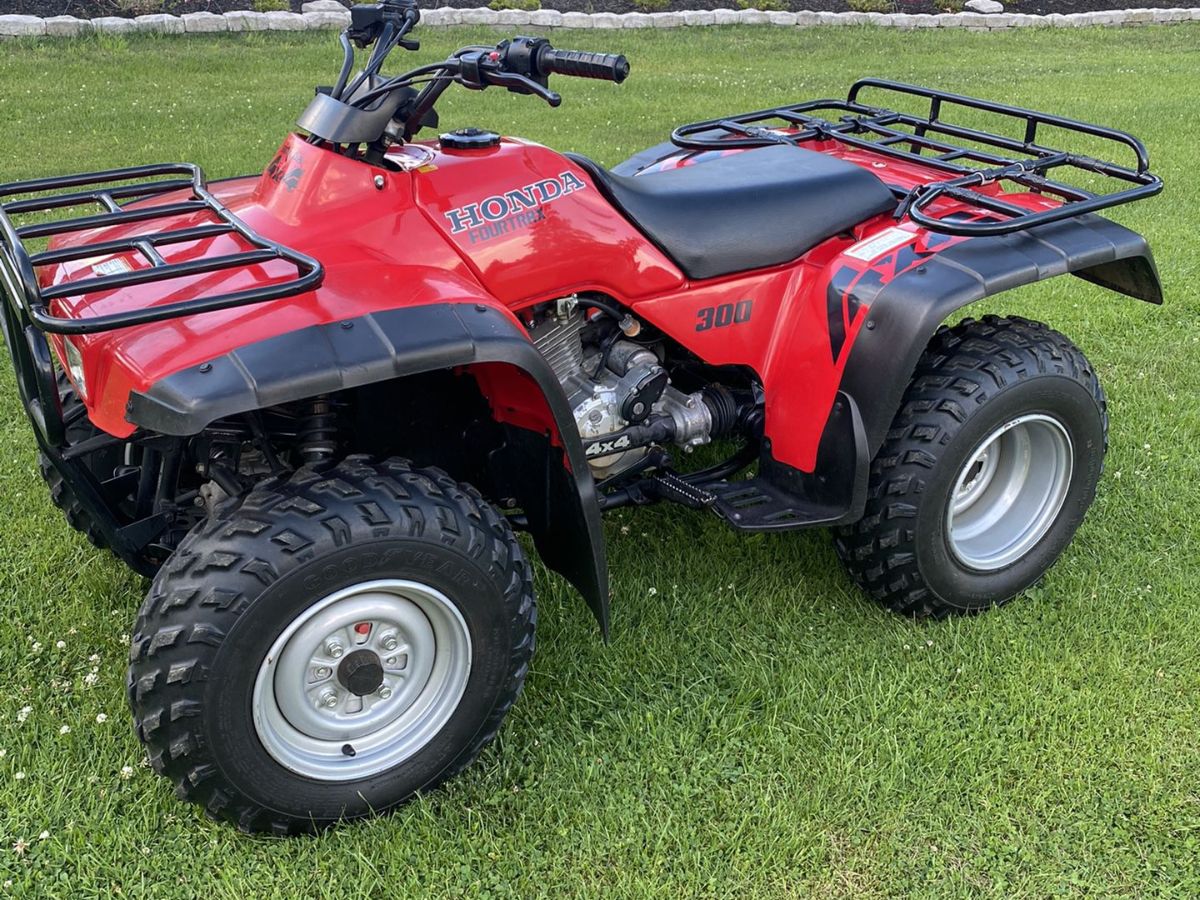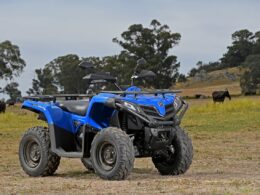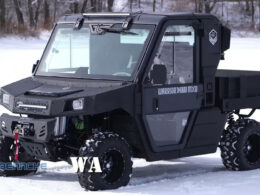In This Article Show
Over the span of my off-roading adventures, spanning years, and various terrains, I’ve come face to face with a slew of challenges. From tackling treacherous paths on dirt bikes to gliding over rugged landscapes in UTVs, the experiences have been both thrilling and educative.
Among the trusty companions I’ve often relied upon in these escapades is the Honda FourTrax 300 – a machine as resilient as they come. However, like any piece of machinery, it isn’t immune to wear and tear.
The Honda FourTrax 300, a cornerstone in the ATV world, boasts reliability that has endeared it to many. Yet, as with any vehicle, frequent usage can lead to common issues that, if left unchecked, might cut short an exhilarating ride. But fear not, because understanding these problems and knowing how to solve them can make all the difference.
Let’s dive into the common problems of the Honda FourTrax 300 and arm you with solutions, ensuring your rides remain smooth and uninterrupted.
1. Transmission Issues
The transmission system is the heart of any vehicle’s movement, and the Honda FourTrax 300 is no exception. Smooth-shifting is essential for optimal performance, but over time, some users have encountered hiccups in this department.
Let’s delve into these issues and offer some fixes.
Problem: Difficulty in shifting or sticking in gear.
Why this happens: Prolonged usage, dirt accumulation, or a lack of lubrication can lead to shifting problems. Moreover, worn-out components can cause gears to stick.
Solution
- Routine Maintenance: Regularly check the transmission fluid levels. If the fluid is dark or has a burnt smell, it’s time to change it.
- Clutch Adjustment: A misaligned clutch can hinder seamless shifting. Adjusting it according to the manufacturer’s guidelines can solve the problem.
- Component Inspection: Periodically inspect the gear shift lever and linkage for wear or damage. Replacement of these components might be necessary if they’re past their prime.
Proper transmission care is more than just addressing issues; it’s about preventing them. By keeping an eye on the transmission components and ensuring they’re well-lubricated, you can prolong the life of your ATV and enjoy many smooth rides ahead.
2. Carburetor Problems
The carburetor plays a pivotal role in blending air and fuel, ensuring that your engine receives the right mixture for optimal combustion. However, when it falters, your ATV’s performance can take a noticeable hit.
Let’s break down some common carburetor issues and how to address them.
Problem: Stalling, poor acceleration, or the engine won’t start
Why this happens: Dirt, debris, or old fuel can lead to deposits in the carburetor. Over time, these deposits can clog the tiny jets and passages, hampering the fuel and air mix.
Solution
- Carburetor Cleaning: Remove the carburetor and use a carb cleaner spray to clean its components. Compressed air can help in clearing out stubborn blockages from the jets.
- Fuel Check: Old or contaminated fuel can gum up the carburetor. Always use fresh fuel, and consider adding a fuel stabilizer if the ATV won’t be in use for extended periods.
- Air Filter Inspection: Ensure the air filter is clean and free of obstructions. A dirty air filter can reduce the amount of air reaching the carburetor, resulting in a rich mixture and poor performance.
Staying proactive about carburetor maintenance can help in circumventing these issues. After all, ensuring that this vital component remains clean and obstruction-free will pave the way for consistent, top-notch performance from your Honda FourTrax 300.

3. Electrical Issues
Electrical systems are the nervous system of any modern vehicle, ensuring everything from ignition to lighting works as it should. When glitches occur, they can lead to frustrating interruptions in your riding experience.
Let’s look at the common electrical issues of the Honda FourTrax 300 and their remedies.
Problem: Non-responsive lights, ignition issues, or a weak battery
Why this happens: A multitude of factors can contribute, from blown fuses, corroded terminals, and old wiring to a depleted battery.
Solution
- Fuse Inspection: Start with the basics. Check all fuses and replace any that are blown. Keep a few spare fuses handy for quick swaps when needed.
- Battery Check: Measure the battery voltage. If it’s below 12V, it might be time for a charge or even a replacement. Remember, routinely inspecting the battery terminals for corrosion and cleaning them can extend battery life.
- Wiring Examination: Over time, wires can fray or get damaged. Regularly inspect the wiring harness for signs of wear. Ensure all connectors are snug and replace any compromised sections.
Taking a systematic approach to diagnosing electrical issues can save a lot of time and frustration.
By attending to these components with care and addressing problems as they arise, you can keep your ATV’s electrical system firing on all cylinders, so to speak, ensuring that your FourTrax 300 remains ready for action.
4. Starter Problems
The thrill of an off-roading adventure often begins with the simple turn of a key or push of a button. But when that action results in nothing more than a silent ATV or a series of frustrating clicks, the culprit is often the starter system.
Let’s explore some frequent starter issues on the Honda FourTrax 300 and how to jump-start the solutions.
Problem: The engine doesn’t turn over or only produces clicking sounds
Why this happens: A malfunctioning starter relay, a worn-out starter motor, or even corroded electrical connections can be at the heart of the issue.
Solution
- Starter Relay Inspection: The relay is what transmits power to the starter motor. If it’s faulty, you might hear a clicking noise. Test the relay with a multimeter, and if it’s not functioning correctly, it’s time for a replacement.
- Check Electrical Connections: Loose or corroded connections can impede the flow of electricity. Ensure that all connections, especially those linked to the starter motor, are clean and tight.
- Starter Motor Evaluation: If the motor itself is worn out or defective, it may struggle to engage or might not work at all. In such cases, a replacement might be the best course of action.
Being stranded with a non-responsive ATV can be disheartening. However, by routinely inspecting the starter system and addressing potential weak points, you can ensure that your Honda FourTrax 300 fires up reliably, every time.
5. Braking System Issues
The ability to stop efficiently and safely is as crucial as the power propelling your ATV forward. The braking system is a testament to the engineering marvel that ensures this safety. For the Honda FourTrax 300, maintaining this system is paramount.
Here’s a look at some common braking system challenges and their resolutions.
Problem: Poor braking response or squeaky noises
Why this happens: Over time, brake pads wear out, brake fluid can get contaminated, or air bubbles can find their way into the brake lines, affecting the system’s efficiency.
Solution
- Brake Pad Inspection: Regularly check the thickness of the brake pads. If they’re worn down to the minimum recommended thickness, it’s time for a replacement.
- Brake Fluid Level and Quality: Ensure the brake fluid reservoir is filled to the recommended level. If the fluid appears dark or murky, consider flushing the system and adding fresh fluid.
- Bleeding the Brakes: Air in the brake lines can lead to a spongy brake feel. Bleeding the brakes can help remove any trapped air, restoring the firmness to the brake pedal.
- Regular Cleaning: Dust and debris can accumulate in the brake assembly. Periodic cleaning can prevent this buildup and reduce squeaky noises.
A well-maintained braking system isn’t just about performance; it’s a critical safety component. By staying attentive to its needs, you’ll ensure that your Honda FourTrax 300 remains responsive to every command, allowing you to tackle terrains with confidence and safety.
6. Suspension and Bearing Issues
Suspension and bearings play a fundamental role in the ride quality of your Honda FourTrax 300. They cushion the ride from rough terrains, ensuring stability and comfort. However, these components can wear out or become compromised, leading to less-than-ideal ride experiences.
Let’s tackle the common problems in this domain and their respective solutions.
Problem: Abnormal tire wear, wobbly rides, or unusual noises while moving
Why this happens: Worn-out bearings, damaged shocks, or misaligned suspension components can result in these symptoms.
Solution
- Bearing Inspection and Greasing: Bearings reduce friction between moving parts. Regularly inspect them for wear, and ensure they’re adequately greased. It might be time for a replacement if you notice grinding noises or excessive play.
- Shock Absorber Check: Damaged or leaking shock absorbers can compromise ride quality. Inspect them for any visible damage or oil leaks. If found faulty, consider replacing them to restore ride comfort.
- Suspension Alignment: A misaligned suspension can lead to uneven tire wear. Regularly checking and adjusting the suspension alignment can help provide a smoother ride and prolong tire life.
- Bushings and Linkages: Ensure that the rubber bushings and linkages connecting various suspension components are in good shape. Worn-out or damaged ones can lead to noises and decreased stability.
Your Honda FourTrax 300 is designed to tackle diverse terrains, and its suspension system is crucial in this endeavor. By ensuring that the bearings and suspension components are in top shape, you can continue to enjoy those exhilarating rides with the comfort and control you’ve come to expect.
7. Overheating Issues
Few things are more alarming than seeing the temperature gauge on your Honda FourTrax 300 edge towards the red, indicating an overheating engine. Overheating can lead to severe engine damage if not promptly addressed.
Let’s explore the typical culprits behind overheating and how to keep things cool.
Problem: Engine temperature rises rapidly, performance drops, or the ATV shuts off after excessive heat
Why this happens: Common causes can range from low coolant levels and blocked radiators to malfunctioning water pumps or compromised thermostat.
Solution
- Coolant Check: Ensure that the coolant level is within the recommended range. Top it up if necessary and inspect for any leaks that might be causing a drop in levels.
- Radiator Inspection: Over time, mud, leaves, or debris can clog the radiator fins, restricting airflow and cooling capacity. Clean the radiator regularly and make sure there’s no obstruction.
- Water Pump Evaluation: The water pump circulates the coolant throughout the engine. If it’s malfunctioning, the coolant won’t flow effectively. Listen for unusual noises or check for leaks, which could indicate a pump issue.
- Thermostat Function: A stuck thermostat can prevent the coolant from flowing into the engine. If suspecting this issue, consider replacing the thermostat.
Overheating can be daunting, but with proactive maintenance and regular checks, you can ensure that your Honda FourTrax 300 remains cool and performs efficiently, even on the most demanding trails.
8. Exhaust and Emission Control Issues
The exhaust system of your Honda FourTrax 300 not only helps expel burnt gases but also plays a crucial role in optimizing engine performance and ensuring adherence to emission standards.
However, a compromised exhaust system can affect your ATV’s performance and environment. Let’s get into the challenges and their fixes.
Problem: Loud exhaust noise, reduced engine performance, or unusual smells
Why this happens: Issues can arise from a rusted or damaged exhaust pipe, malfunctioning muffler, or clogged catalytic converter.
Solution
- Exhaust Pipe and Muffler Inspection: Check the entire exhaust system length for any visible signs of damage, rust, or holes. A damaged exhaust can be loud and negatively affect engine performance. Replacement or repairs might be necessary based on the extent of the damage.
- Catalytic Converter Check: A clogged or malfunctioning catalytic converter can reduce engine power and increase emission levels. If you notice a sulphur-like smell or significant reduction in performance, it might be time to inspect or replace the converter.
- Emission Controls: Modern ATVs come with emission control systems to reduce environmental impact. Ensure sensors and valves are functioning correctly and replace them if found faulty.
A healthy exhaust system is vital for the optimal performance and environmental responsibility of your Honda FourTrax 300. With regular checks and maintenance, you can ensure that your ATV runs smoothly while minimizing its environmental footprint.
Tips for Regular Maintenance
To prolong the life of your Honda FourTrax 300 and ensure that it always delivers peak performance, regular maintenance is key. Instead of waiting for problems to emerge, proactive care can ward off many common issues.
Here are some top maintenance tips to keep your ATV in the best shape possible.
Routine Oil Change
- Importance: Just like any vehicle, the FourTrax 300 requires regular oil changes to lubricate its internal parts efficiently.
- Tip: Check the manufacturer’s recommendations for frequency and type of oil. Remember, using the right oil grade is essential.
Air Filter Maintenance
- Importance: A clean air filter ensures the engine gets a steady supply of clean air, essential for optimal combustion.
- Tip: Regularly check, clean, or replace the air filter, especially if you ride in dusty or muddy conditions.
Tire Checks
- Importance: Proper tire inflation and condition ensure good traction and safer rides.
- Tip: Inspect tires for wear, punctures, and ensure they’re inflated to the recommended PSI.
Lubrication of Moving Parts
- Importance: Keeping parts well-lubricated reduces wear and tear.
- Tip: Periodically lubricate joints, bearings, and other moving parts to reduce friction and enhance longevity.
Fuel System Care
- Importance: A clean fuel system promotes efficient combustion and performance.
- Tip: Use fresh gasoline and consider adding a fuel stabilizer if storing the ATV for prolonged periods.
Regular Inspection
- Importance: Catching potential issues early can prevent more significant problems down the road.
- Tip: Periodically inspect brakes, lights, cables, and other essential systems.
Storage Precautions
- Importance: Proper storage can prevent various issues, from battery drain to rust.
- Tip: When not in use, store your ATV in a dry place, preferably covered. If storing for a long time, disconnect the battery and consider using a fuel stabilizer.
Proactive and regular maintenance of your Honda FourTrax 300 ensures that it’s always ready for the next adventure and helps retain its value over the years.











